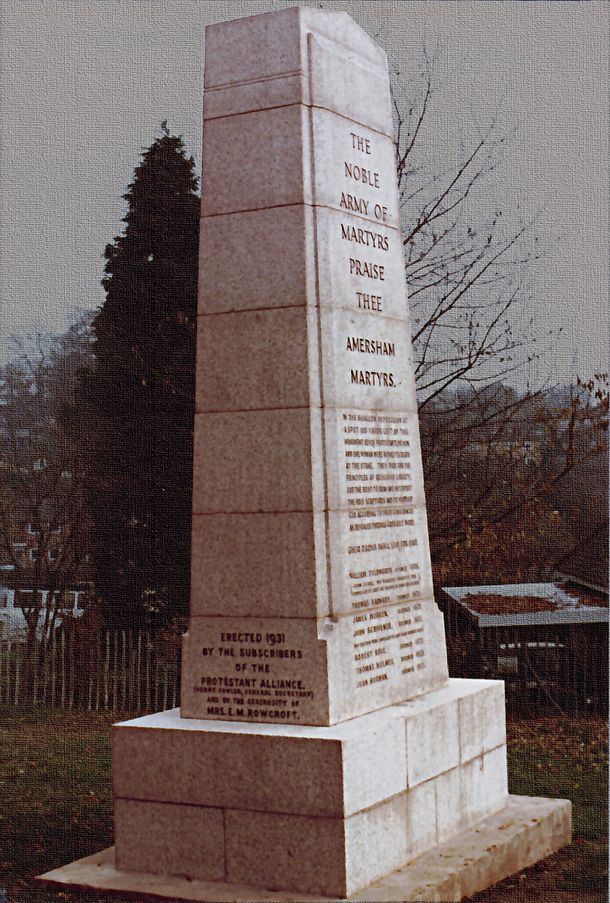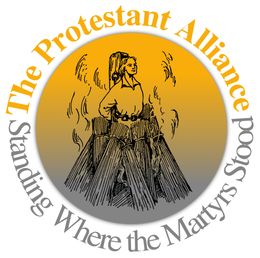
Amersham Martyrs’ Memorial
The Martyrs' Memorial at Amersham was erected by the Protestant Alliance in 1931.
It was unveiled by Mrs L R Raine a direct descendant of Thomas Harding, one of the Martyrs commemorated.
The main inscription reads:
"The Noble Army of Martyrs Praise Thee
Amersham Martyrs
In the shallow depression at a spot 100 yards left of this monument, seven protestants, six men and one woman were burned to death at the stake. They died for the principles of religious liberty. For the right to read and interpret the Holy Scriptures and to worship God according to their consciences as revealed through God's Holy Word. Their names shall live for ever."
Location of Amersham Martyrs' Memorial
Introduction
The Amersham Martyrs were Lollards. The Lollards were the followers of the teachings of John Wycliffe and pre-date the Reformation. Six men and one woman were burned to death at Amersham, all barbaric, the degree of cruelty shown to some the is beyond all reasonable comprehension.
1506 The Year of the Great Abjuration
William Tylesworth was the first of the Amersham martyrs and was put to death in 1506. He appears to have been a leader of the Lollards in the area and may have possessed a Wycliffe Bible or a portion of Scripture.
Bishop Smith of Lincoln, whose diocese included Amersham, was determined to eliminate the Lollards. He targeted the Lollards' leaders to make an example of them and strike terror in the hearts of their followers.
They achieved much of their aim and 60 Lollards abjured (renounced) their faith including Tylesworth's only daughter, Joan Clark, and her husband. The 60 were branded on the cheek with a hot iron, made to wear a symbol of a faggot, and on certain festival days had to parade with a faggot on their shoulder and a lighted torch in their hand. They lived under the threat that if they expressed their former beliefs they would be immediately burned alive.
Despite her abjuration and branding Joan was still forced to light the fire that took her father's life.
1506 was called the year of the Great Abjuration for years afterwards because of the number of Lollards forced to renounce their faith. Bishop Smith failed in his attempt to crush the faith of the Lollards completely.
1521 - Five More Burnings at Amersham
In 1521 another Bishop, John Longland, made a much more determined effort to eradicate Lollardry. Careful enquiries were made and those suspected of being Lollards were rounded up.
The five that were put to death were burned in groups of two and three; they were not wealthy or cultured but labourers, husbandmen and a housewife. Their only crimes were to meet in secret with others to pray and to read the Bible.
The Bishop and his officers used every device to entrap these humble souls. Children were made to fear for their lives to give evidence against their parents and parents against their children.
Details are scarce on the Lollard Martyrs but we know that Thomas Barnard, a husbandman, and James Morden, a labourer, were burned in a single fire.
John Scrivener's children were forced to start the fire that consumed their father. John Foxe wrote: "The example of which cruelty, as it is contrary both to God and nature, so it hath not been seen or heard of in the memory of the heathen."
Thomas Holmes had sadly disclosed details on many of his brethren in Christ hoping to please the Bishop and save himself. His attempts to save his life were futile and he was burned alive, as were Robert Rave and Joan Norman, a housewife.
More Deaths
Thomas Man confessed to having turned seven hundred people to his religion and doctrine, for which he thanked God. He was burned at Smithfield in 1518.
Robert Cosin of Great Missenden had a mill which was used by the Lollards was burned at Buckingham for his faith in 1518. He was affectionately known by them as "Father Robert." Man and Cosin influenced Joan Norman not to go on pilgrimages, nor to worship any images of saints, nor to give confession to a priest and they were charged by the Bishop for teaching her that she might as well drink on the Sunday before the Mass as on any other day.
Thomas Harding was the last of the Lollard Martyrs, was burned at Chesham in 1532. When they had set fire to the elderly saint, someone threw a log at him that "dashed out his brains" and so he died.
Thomas Chase was a godly, sober and honest man who could not abide idolatry or superstition and often spoke against it. He was arrested and thrown into the wicked dungeon called "Little Ease." It was a damp, dark place designed so that it was not possible to sit, stand or lie down in comfort. Taken from this awful place in the Bishop's Palace he was beaten to death by the servants of the Bishop. Those murderous servants of the Bishop spread the rumour that he had committed suicide and hid his body in Norland Woods so that an autopsy could not be carried out and their dastardly deed revealed and punished.
